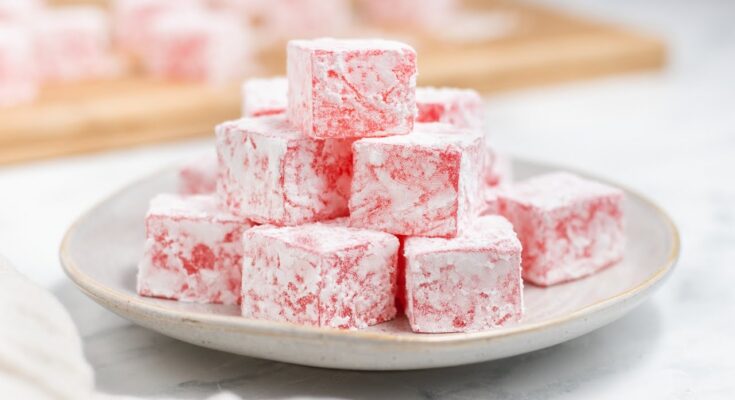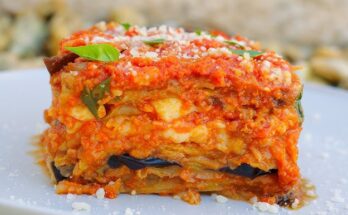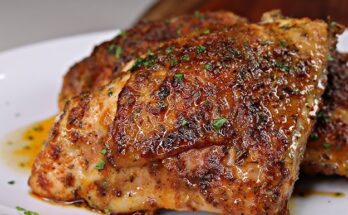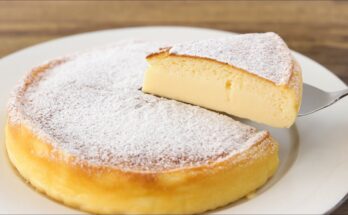Turkish Delight Recipe: Turkish Delight, known as Lokum in Turkish, is a traditional sweet that’s become a symbol of Turkish hospitality and culture. These soft, chewy, fragrant cubes are dusted in powdered sugar and often flavored with rosewater, lemon, or mastic. They are sometimes embedded with nuts like pistachios or hazelnuts, offering a delightful contrast of texture and flavor. Turkish Delight isn’t just a dessert—it’s an experience that bridges centuries of history with every bite.
Turkish Delight has a uniquely smooth, gel-like texture unlike anything else. It’s not a gummy candy nor a fudge; instead, it has a delicate chewiness that makes it addictive and satisfying. While it might seem complicated to make, once you understand the process, it’s straightforward and well worth the effort.
Whether served with tea or given as a gift, Turkish Delight brings a taste of the exotic with every square. The magic lies in the texture and flavor combinations, making it a favorite among people who enjoy traditional treats from around the world.
A Brief History and Cultural Significance
Turkish Delight dates back to the Ottoman Empire, where it was first created in the 18th century. Legend has it that a sultan, weary of hard candies, commissioned his chefs to create a softer, more luxurious sweet—and thus Lokum was born. It quickly became a royal favorite and spread throughout the empire, eventually gaining international fame, particularly in Europe during the 19th century.
Today, Turkish Delight is still deeply woven into the fabric of Turkish culture. It’s customary to serve it during special occasions such as weddings, religious holidays like Eid, and when receiving guests. The sweet has also inspired many writers and artists, famously making its way into literature, such as in C.S. Lewis’ The Lion, the Witch, and the Wardrobe.
This dessert is more than just a sweet—it’s a piece of history. When you make Turkish Delight at home, you’re not just cooking; you’re participating in a centuries-old tradition.
Ingredients Required
Basic Ingredients for Traditional Turkish Delight
To make a classic Turkish Delight, you don’t need exotic ingredients. Here’s what you’ll require for a basic batch:
- 4 cups granulated sugar
- 1 ½ cups water (divided)
- 1 cup cornstarch
- 1 tsp cream of tartar
- 1 tbsp lemon juice
- 1–2 tsp rosewater (or any other essence)
- Powdered sugar (for dusting)
Sugar forms the core of Turkish Delight—it’s the ingredient that gives the candy its sweetness and structure. Cornstarch, on the other hand, provides the jelly-like texture. Cream of tartar helps prevent the sugar from crystallizing during cooking.
Rosewater is the most classic flavor, but you can substitute it with lemon, orange blossom water, or even mint. Each gives the delight its own unique twist.
Optional Flavorings and Additions
You can get creative with Turkish Delight by adding nuts or using different flavors. Here are some ideas:
- Nuts: Pistachios, hazelnuts, or walnuts
- Dried fruits: Chopped dried apricots or cranberries
- Flavorings: Orange blossom, lemon zest, vanilla, mint
- Colors: Natural food coloring (beetroot for pink, turmeric for yellow)
Using food coloring is optional but can make your Turkish Delight more visually appealing—especially if you’re giving it as a gift. Just a few drops can transform a plain batch into a festive treat.
If you’re going for authenticity, rosewater and pistachios are a perfect match. The floral aroma paired with the crunch of pistachios offers a delicious sensory experience.
Tools and Equipment You’ll Need
Kitchen Tools for Turkish Delight
You don’t need fancy tools to make Turkish Delight, but a few essentials will make the process easier and more accurate:
- Heavy-bottom saucepan
- Whisk and wooden spoon
- Candy thermometer
- Measuring cups and spoons
- 8×8-inch baking pan
- Sharp knife or bench scraper
- Sieve or strainer (for dusting sugar)
A candy thermometer is especially important as sugar needs to reach the soft ball stage (around 240°F or 115°C). Without it, you’re essentially guessing—and Turkish Delight is too finicky for guesswork.
Make sure to prepare your work area ahead of time. The mixture thickens quickly once heated, so you won’t have time to scramble for missing tools.
Choosing the Right Pan and Thermometer
When selecting a pan, go with a heavy-bottomed one. Thin pans can lead to uneven heating, which might cause your sugar to burn or your cornstarch to clump.
A digital or analog candy thermometer will help you monitor the temperature precisely. Turkish Delight is all about the right texture, and hitting the exact temperature ensures it’s not too soft or too hard.
Line your baking pan with parchment paper and lightly grease it before pouring in the mixture. This prevents sticking and makes it easier to remove once it’s set.
Preparing the Turkish Delight
Step 1: Dissolving the Sugar
In a heavy-bottomed saucepan, combine 4 cups of granulated sugar with 1 ½ cups of water and the lemon juice. Stir over low heat until the sugar completely dissolves. Then, increase the heat and allow the mixture to boil. Use a candy thermometer to monitor the temperature—it should reach 240°F (115°C).
Be patient with this step. Don’t stir the mixture once it starts boiling, as this can cause crystallization. Just let it bubble away until it reaches the desired temperature.
This sugar syrup is the backbone of Turkish Delight. Getting it right sets you up for success in the next steps. It should be clear and slightly thick when done—not caramelized or browned.
Step 2: Creating the Cornstarch Paste
While your sugar syrup is boiling, it’s time to prepare the cornstarch mixture. In a separate large saucepan, mix 1 cup of cornstarch, 1 teaspoon of cream of tartar, and 1 cup of cold water. Stir constantly to dissolve the cornstarch and eliminate lumps. Then slowly add ½ cup of boiling water while stirring.
Heat this mixture over medium-low heat, continuing to stir. It will gradually thicken into a smooth, glue-like paste. This step is crucial for that signature chewy, gel-like consistency. It may take about 10–15 minutes, but don’t rush it.
If it starts to clump, don’t panic—just keep stirring vigorously with a whisk or wooden spoon until it smooths out. This thick base is what will hold your Turkish Delight together. The goal here is a silky, elastic texture that’s free of lumps or bubbles.
Step 3: Combining Mixtures and Cooking
Now comes the fusion of the two mixtures. Slowly pour the hot sugar syrup into the cornstarch paste, stirring continuously. This should be done gradually and carefully to prevent shocking the starch and causing lumps.
Once combined, reduce the heat to low and keep stirring. This part takes patience. You’ll need to cook the mixture gently for about 45 minutes to an hour, stirring frequently to prevent sticking or burning. The mixture will transform into a glossy, thick, golden gel.
This slow cooking process ensures that the water evaporates and the sugars and starch bond properly. You’ll know it’s ready when the mixture becomes very thick, pulls away from the sides of the pan, and has a shiny, cohesive look.
Be cautious—this sugar gel is very hot and sticky, so avoid touching it directly. Use a wooden spoon to test its consistency; it should fall off slowly and stretch slightly like taffy.
Flavoring, Setting, and Cutting
Adding Flavors and Colors
Once your Turkish Delight mixture is cooked, remove it from the heat and immediately stir in your chosen flavoring—classic rosewater, orange blossom, or lemon extract work beautifully. If you want to add food coloring, now is the time. Just a few drops will give your Lokum a vibrant hue.
Mix thoroughly to evenly distribute the flavor and color. If you’re including nuts or dried fruits, fold them in gently but quickly while the mixture is still warm.
Flavors should be subtle—not overpowering. Turkish Delight is known for its elegance and delicacy, not overwhelming sweetness or strong aroma.
Cooling and Setting Properly
Pour the hot mixture into your prepared baking pan, spreading it evenly with a spatula. Let it sit uncovered at room temperature for at least 6 hours, preferably overnight. Avoid refrigerating, as this can make the texture rubbery instead of soft and chewy.
The setting process is critical. Rushing it will result in a gooey mess instead of those clean, velvety cubes you’re after. After cooling, the surface should be firm but still have a slight bounce to the touch.
Once fully set, dust the surface generously with a mix of powdered sugar and cornstarch. This prevents sticking and adds that iconic snowy finish.
Cutting and Dusting the Delight
Carefully remove the Turkish Delight from the pan by lifting the parchment paper. Use a sharp knife or bench scraper greased with a bit of oil to cut the slab into squares. Don’t forget to dust the knife between cuts to avoid sticking.
Once cut, toss the cubes in a bowl of powdered sugar and cornstarch mixture to coat them thoroughly. This not only prevents sticking but also gives each piece a beautiful, classic look.
Store Turkish Delight in an airtight container at room temperature. Separate layers with parchment paper and sprinkle a little extra powdered sugar if needed. It can last up to 2 weeks—though it rarely stays uneaten that long!
Serving and Storing Turkish Delight
Best Ways to Serve Turkish Delight
Turkish Delight is traditionally served with a hot cup of strong black tea or Turkish coffee. Its delicate sweetness perfectly complements the bitter and aromatic notes of these drinks. If you want to impress guests or give your dessert table an elegant flair, serve the cubes on a silver tray with small toothpicks or tiny tongs for a true Middle Eastern presentation.
You can also pair Turkish Delight with nuts, dried fruits, or dark chocolate to create a more decadent dessert platter. Some people enjoy it alongside cheese and crackers for a sweet-savory contrast.
Another fun idea is to use Turkish Delight in baking. Chop it up and fold it into muffins or cakes for an unexpected burst of floral sweetness. Or layer pieces into trifles for a Middle Eastern twist on a classic British dessert.
Storage Tips to Maintain Freshness
Proper storage is essential if you want to enjoy your Turkish Delight over several days. Here’s how to do it:
- Use an airtight container: This prevents the candy from drying out or absorbing moisture from the air.
- Store at room temperature: Avoid the fridge; it can ruin the texture.
- Dust with powdered sugar and cornstarch before storing: This helps prevent sticking and keeps the pieces dry.
- Use parchment between layers: If stacking, add a layer of parchment paper in between to keep them from sticking together.
When stored properly, Turkish Delight can stay fresh for up to two weeks. If it begins to weep (release moisture), just roll it in fresh powdered sugar and cornstarch to refresh it.
Tips and Tricks for Perfect Turkish Delight
Common Mistakes and How to Avoid Them
Even seasoned cooks can run into issues when making Turkish Delight. Here are a few common problems and how to fix them:
- Grainy Texture: This usually means the sugar crystallized. Avoid stirring once the sugar syrup starts boiling, and make sure your pot is clean.
- Too Soft or Too Firm: This comes down to temperature. Use a candy thermometer and don’t guess. The syrup must reach 240°F (115°C).
- Clumping: Stir the cornstarch mixture continuously until smooth, and combine it gradually with the sugar syrup.
- Sticky Surface: You didn’t use enough powdered sugar and cornstarch. Be generous with dusting and re-dust as needed.
Flavor Pairing Suggestions
Want to get creative with your Turkish Delight? Try these flavor combinations:
- Rosewater & Pistachio – the classic, elegant combo.
- Orange Blossom & Almond – floral with a nutty finish.
- Lemon & Poppy Seed – fresh and citrusy with a bit of crunch.
- Mint & Dark Chocolate Chips – a modern twist with cooling notes.
You can even experiment with matcha, cinnamon, or vanilla bean to give your delight a unique flavor profile.
Healthier Alternatives and Dietary Tips
Making Vegan or Sugar-Free Turkish Delight
Traditional Turkish Delight is naturally gluten-free and vegan-friendly (if you skip any gelatin additions). But if you’re looking to make it even healthier or cater to dietary needs, here are some alternatives:
- Vegan: Use only cornstarch for thickening—skip gelatin entirely. Most traditional recipes are already vegan.
- Sugar-Free: Replace sugar with erythritol or a similar heat-stable sugar substitute. Be cautious though—these may alter texture.
- Natural Colors and Flavors: Use beet juice for red, turmeric for yellow, and spinach or matcha for green. For flavoring, try using real citrus zest or herbal extracts.
Though these alternatives can work well, they may slightly change the texture or setting time of the final product. Always test small batches first before scaling up.
FAQs about Turkish Delight Recipe
1. What is Turkish Delight made of?
Traditional Turkish Delight is made from sugar, water, cornstarch, and flavorings such as rosewater, lemon, or orange. It may also include nuts like pistachios or hazelnuts.
2. Is Turkish Delight difficult to make at home?
While it requires attention and patience, Turkish Delight can be made at home using simple ingredients. The key is to monitor the temperature and stir consistently for a smooth, jelly-like texture.
3. How long does homemade Turkish Delight last?
If stored in an airtight container and kept in a cool, dry place, homemade Turkish Delight can last up to 2-3 weeks. Avoid storing it in the refrigerator as moisture can affect its texture.
4. Can I make Turkish Delight without gelatin?
Yes. Traditional recipes use cornstarch instead of gelatin to achieve the chewy texture, making it suitable for vegetarians and those avoiding animal products.
5. What flavors can I use for Turkish Delight?
Common flavors include rose, lemon, mint, pomegranate, and orange. You can experiment with natural extracts or fruit juices to create your preferred taste.
6. How do I prevent Turkish Delight from being too sticky?
After cutting the pieces, dust them generously with a mixture of powdered sugar and cornstarch to absorb moisture and prevent sticking.
7. Is Turkish Delight gluten-free?
Yes, most traditional recipes are naturally gluten-free as they use cornstarch instead of wheat flour. Always check labels if using store-bought ingredients.
Conclusion
Turkish Delight is more than just a sweet treat—it’s a culinary journey back in time, steeped in history, culture, and tradition. Making it at home might seem intimidating at first, but once you understand the process and follow each step carefully, it becomes an enjoyable and rewarding experience. From boiling the sugar to folding in flavors, every stage contributes to creating those perfectly chewy, flavorful cubes that have been adored for centuries.
So, gather your ingredients, prepare your tools, and dive into the world of Turkish Delight. Once you master this classic confection, you’ll never look at store-bought sweets the same way again.



